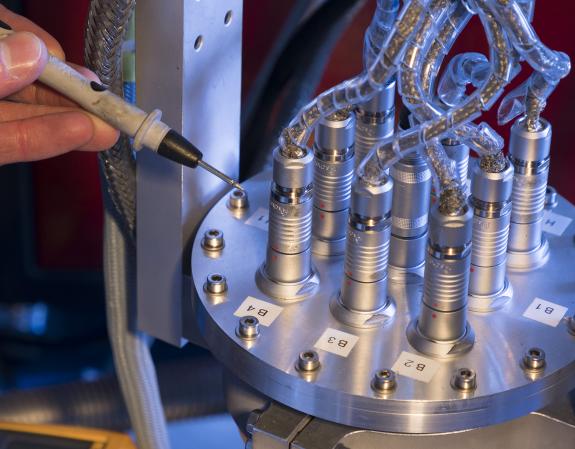
The missions of the National Network of French Metrology are mainly: the practical realization of SI units and the implementation of national standards to allow access for users from all origins (research, industry or control organizations) to metrological references they need, within the framework of rigorously established traceability.
Missions
SI Units and fundamental research
The units of the International System of Units (SI) are at the core of the RNMF's missions. The aim is to guarantee the highest national reference level for the conservation of units and their implementation for calibrations useful to the industry and French economy.
- The generic axes are therefore: maintaining the existing reference standards up to the most advanced level of uncertainty;
- The operation of these reference and transfer standards (first step in the calibration chain), their multiples and submultiples and the scales associated with certain units ;
- The constant improvement of existing uncertainty levels according to the needs expressed by industry, medicine or society;
- The development of tomorrow's references, (such as in the world of nanometrology, or biology, for example);
- The implementation of reference means and methods for various types of quantities in various ranges of useful values.
More fundamentally, it requires the teams to conduct research with metrological implications contributing to the improvement of definitions, their realizations and the practical applications of the base units and the main derived units playing a fundamental role in the SI. In particular, this is all the upstream work carried out as part of the redefinition of the SI, ratified during the 2018 CGPM.
Inter-laboratories comparisons
The consistency of the international system of units and of all practical applications requires frequent comparisons of results between NMIs.
Within this framework, the main missions consist of:
- Ensuring, and if necessary leading, all the useful comparisons (key comparisons of the CIPM, of EURAMET, comparaisons within the European and international metrological organizations, bilateral comparisons, etc.) in order to ensure the international equivalence of the national, primary, secondary standards, of the measuring scales as well as the reference methods and materials of the National Metrology Institutes (NMIs), all this as part of the MRA (Mutual Recognition Arrangement published by the CIPM).
- Under this mission, ensuring the French presence in the CIPM’s Consultative Committees, within the EURAMET and in other working groups in the areas of metrology.
Metrological traceability and dissemination of references
The traceability of measurements to SI units requires the first step of connecting an accredited laboratory. To do this, the study, development and operation of the means of transfer and calibration may be necessary. These aspects therefore also fall within the missions of the RNMF. Some calibration services cannot be provided by accredited laboratories (in particular because of insufficient direct profitability, high equipment costs in relation to the number of services, when the necessary equipment is scarce or for scientific, technical or strategic reasons). In these extreme, specific and limited cases, the network has the mission to perform the calibration directly for the user.
Training and knowledge dissemination
All the French national metrology network (RNMF) laboratories, led by the LNE, are contributing to valorizing the experience gained by participating in training in the field of metrology, in the dissemination of technologies and in the transfer of competencies towards the economic and social systems of France and abroad as part of co-operation agreements and through the publication of the results obtained.
They provide COFRAC, the French accreditation network their support for operating the national system of accreditation, notably by participating in the accreditation technical commissions and by leading inter-laboratory comparisons.
Finally, the network contributes to the training of industrials in the field of metrology, but also to the training of students (among others via theses). Training actions, via technical sessions or courses are therefore carried out.